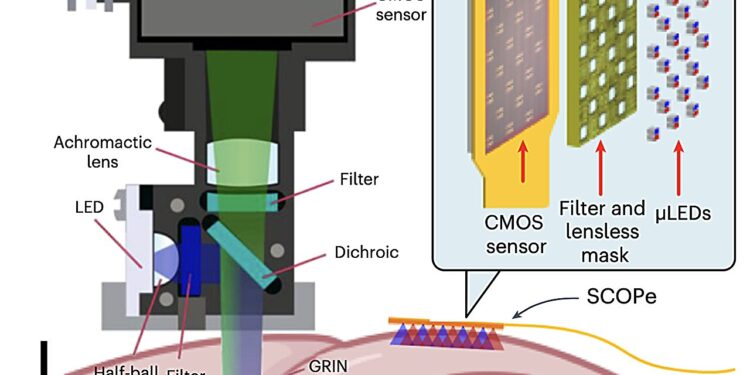Comparison of the displacement factor of miniature microscopes. a, Comparison of the scale size of the Miniscope9 and the SCOPe developed here. Credit: Natural electronics (2024). DOI: 10.1038/s41928-024-01209-w
Reliably tracking and manipulating the mammalian nervous system in the laboratory or clinic allows neuroscientists to test their hypotheses, which could in turn lead to important new discoveries. The best-known and most widely used technologies for studying the brain use electrodes, devices capable of monitoring or stimulating electrical activity in their environment.
Yet recent studies in mice, nonhuman primates, and other mammals have also highlighted the promise of optical and optogenetic techniques for studying neuronal activity in the mammalian brain. The advantage of optical techniques is that they can target specific neuronal populations with high levels of precision, at greater distances and spanning larger cortical areas, allowing neuroscientists to meticulously track and modulate the neuronal activity.
Despite their potential, these techniques typically rely on the use of large and sophisticated laboratory instruments, such as tabletop microscopes. Some computer scientists and engineers have attempted to introduce less bulky and more affordable solutions, such as miniature lensless microscopes that capture and digitally reconstruct images by performing calculations. Yet even these solutions have limitations, such as lower resolutions than lens-based optical techniques and higher computational requirements.
Researchers at Columbia University, New York University and other institutes recently developed a new subcutaneous optical device that could be used to monitor and stimulate the brain with greater precision. This device, presented in an article in Natural electronicsrelies on an optical probe based on complementary metal oxide semiconductor (CMOS).
“Considerable progress has been made in miniaturizing microscopes for head-mounted configurations, but existing devices are bulky and their application in humans will require a more non-invasive and fully implantable form factor,” wrote Eric H . Pollmann, Heyu Yin and colleagues. in their newspaper. “We report an ultra-thin, miniaturized subdural CMOS optical device for bidirectional optical stimulation and recording.”
The optical probe on which the team’s device is based, called SCOPe, is composed of a flexible, thin, lensless miniature microscope and an optical stimulator. Notably, the probe is thin enough to insert into the subdural space of a primate’s brain; a narrow area between two layers of tissue that cover the mammalian brain, known as the dura mater and the arachnoid.
“We use an application-specific CMOS integrated circuit capable of both fluorescence imaging and optogenetic stimulation, creating a probe with a total thickness of less than 200 µm, thin enough to sit entirely in space subdural of the primate brain,” Pollmann, Yin and colleagues wrote. “We show that the device can be used for imaging and optical stimulation in a mouse model and can be used to decode the movement speed achieved in a non-human primate.”
As part of their study, the researchers tested their device on mice, successfully demonstrating its promise in imaging and optical stimulation of the mouse brain. Subsequently, they also used their device to study the activity of neurons in the motor cortex of non-human primates.
The results collected from their initial tests were very promising, as the device allowed them to image the entire brain region of interest, while also allowing them to correlate the animals’ movements with brain activity. In the future, this promising new technology could open up exciting research possibilities, allowing other neuroscientists to precisely and less invasively manipulate and monitor the activity of specific neurons in animal brains when they are engaged in specific activities.
More information:
Eric H. Pollmann et al, A subdural CMOS optical device for bidirectional neural interface. Natural electronics(2024). DOI: 10.1038/s41928-024-01209-w
© 2024 Science X Network
Quote: New ultra-thin optical device can precisely capture and stimulate mammalian brains (October 6, 2024) retrieved October 6, 2024 from
This document is subject to copyright. Except for fair use for private study or research purposes, no part may be reproduced without written permission. The content is provided for informational purposes only.



